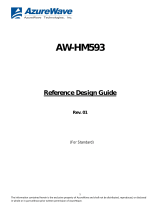
3
The information contained herein is the exclusive property of AzureWave and shall not be distributed, reproduced, or disclosed in
whole or in part without prior written permission of AzureWave.
Table of Contents
Revision History .............................................................................................................................. 2
Table of Contents ............................................................................................................................ 3
List of Figures .................................................................................................................................. 3
List of Tables ................................................................................................................................... 3
1. Reference Schematic .................................................................................................................. 4
2. Design Considerations ............................................................................................................... 7
2.1 Power Supply ..................................................................................................................... 7
2.2 CapSense ........................................................................................................................... 8
2.3 Debug Pins ....................................................................................................................... 10
2.4 P Pin parasitic capacitance ............................................................................................ 10
List of Figures
Figure 1 ............................................................................................................................................. 7
Figure 2 ............................................................................................................................................. 7
Figure 3 ............................................................................................................................................. 8
Figure 4 ............................................................................................................................................. 8
Figure 5 ............................................................................................................................................. 9
Figure 6 ............................................................................................................................................. 9
List of Tables
Table 1............................................................................................................................................. 10
Table 2............................................................................................................................................. 12


















